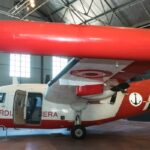The P-166 light twin-engine aircraft was built for over 30 years for roles ranging from utility to maritime patrol, with different engines and mission equipment. It is easily recognized by the Piaggio pusher configuration, introduced by on the P-136 and still in use on its latest P-180. The P-166 was designed by Dr. Ing. Giovanni Casiraghi, who mated the wing and empennage of the P-136 amphibian to an all-new fuselage. The prototype flew on 26 November 1957 from Villanova d’Albenga with Aldo Gasperi. The main production model was the M (for Military) variant, 51 of which were used by the Italian Air Force. South Africa purchased the S version for maritime patrol. The turboprop-engined -DL3 was designed by Dr Ing Alessandro Mazzoni and was flown on 3 July 1976 by Evasio Ferretti. Production totalled 36 aircraft for the Italian Air Force, Italian Coast Guard, Italian Treasury Guard, the Alitalia flying school and Somalia. The P-166-DL3 on display (construction number 487, military serial MM.25165) made its first flight on 22 September 1989, captained by Danilo Cazzola. Ferried to its operating base on 23 February 1990, it served with the Coast Guard with the radio call-sign “Orca 7”. Fitted with nose-mounted radar, FLIR and searchlight for maritime patrol, it ended its service with the Catania air station, alter 2371,45 flying hours and 1874 landings. It made its last flight on 24 September 2007. Presented to Volandia by Piaggio Aerospace, it is the only P-166-DL3 on display in a museum.
Piaggio P-166
Aircrafts

Technical Specifications
Name :
P-166-DL3
Family :
Twin-engine Patrol
Manufacturer :
IAM Rinaldo Piaggio
Nation :
Italy
Production Year :
1976
Dimensions
Length :
11.88 m
Span :
14.69 m
Height :
5.00 m
Wing Area :
26.56 m²
Weights
Empty :
2650 kg
Maximum Take-off :
4500 kg
Engines
2 Textron Lycoming LTP-101-A-700-1A Turboshaft
600 SHP
Performances
Maximum Speed :
407 km/h
Range :
2056 km
History



